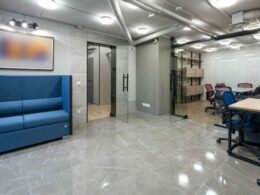If you’re looking for a coworking space, but are scouring the different offerings available for you to move into, you will face this dilemma, at one point or the other. What mix of privacy and community is the perfect mix for my organization? While community can directly boost employee productivity, often acting as a source of inspiration, it is essential that your employees’ right to privacy are adequately taken care of.
In fact, one of the leading reasons that people used to prefer traditional office spaces is to ensure that corporate secrets and other sensitive data remain within the company walls.
However, as coworking spaces evolved, there has been an increasing number of coworking spaces offering adequate offerings and features ensuring adequate privacy for their employees. So, the question really becomes, what are the signs I should look out for, to make sure that my business’ necessities are adequately met by my desired coworking space?
Before getting into that, it is imperative that we deal with the nuances of how coworking spaces tend to define the two seemingly contradicting terms – “Community” and “Privacy”. Let’s face it, these are the two most important factors you should think about when choosing the right coworking space for your organization.
Community and Privacy
While communities have evolved since the beginning of human civilization, the proper usage of the term community in the context of businesses is relatively modern. A community can be defined as the term wherein we talk about working together with like-minded individuals, across different organizations, to ensure mutual growth and success.
Coworking spaces tend to place a huge emphasis on the community by engaging the businesses in networking activities regularly.
Sometimes, these activities happen on a daily basis, ensuring healthy engagement rates from all its occupants. There exist coworking spaces that focus 100% on building communities, and these spaces tend to be filled up with freelancers and initial stage start-ups.
On the other side of this equation comes privacy. In the context of a coworking space, privacy can be defined as the need to protect employee privacy, corporate identity, corporate secrets, sensitive documents and information etc.
Privacy-oriented coworking spaces tend to have little to no open spaces, and typically a cabin structured setting. This allows little to no transparency, or interaction between businesses.
Traditional business centres provide 100% privacy. There exists no open office environment, and inter-organization interaction is virtually non-existent.
While both offerings have definite advantages, they also come with their fair share of disadvantages.
For instance, it is possible that too much emphasis is laid on networking, distracting coworkers from their core functions.
Privacy, obviously, becomes an issue, as community and privacy are often seen as a trade-off. On the other hand, if your coworking space offers little in terms of community-building activities, your business could miss out on the growth and development benefits that being in a well-nurtured community can offer.
However, it is important to understand that there is no one-size-fits-all solution when it comes to the community vs privacy dilemma. If you’re a startup or any company in the growth stage of business, you should probably take the maximum advantage of community-oriented coworking spaces.
On the other hand, if you’re a big company, looking for just an office space, and don’t really need to leverage on community, you should be more than happy to be accommodated in some of the traditional business centres.
In all probability, your business might fall somewhere in between these two extreme categories. Don’t worry, we have prepared a matrix that will help you decide what you need to focus on, depending on the nature of your business.
Community vs Privacy Matrix
The fact of the matter is, choosing the right blend of community and privacy is highly dependent on the scale and size of your business operations. Keep in mind that these are just soft guidelines that will help you to decide on the type of coworking space that you might want to sign with. The ultimate decision is on you and should be taken after careful deliberation.

S1 – Warehouse like spaces, very open environment
These are the spaces that focus purely on community building and offer little to no privacy for the coworkers. S1 coworking spaces are usually occupied by freelancers and early-stage startups.
Networking opportunities are aplenty, and the “loneliness” of being a solopreneur or a freelancer doesn’t kick in easily, as you’ll always find like-minded cohorts to converse with regularly.
However, just because you freelance, or are an individual, doesn’t mean that you should automatically pick S1 coworking spaces over anything else. If you’re a trader for example, where you’ll be acting on proprietary information, it is best that you look for a space with better privacy offerings.
In short, if your business even needs a little bit of privacy and secluded space to function properly, do not opt for S1 coworking spaces.
S2 – Corporate like space but with community advantages as well, events and workshops
The ideal blend between the two extremes. The spaces in the S2 section of the matrix allows you to choose the space depending on the characteristics of your organization. Usually, SMEs, startups with good traction and medium-sized businesses tend to flock to the S2 coworking spaces, and for a very good reason.
While offering different privacy features, like separate cabins, private phone booths, etc, these coworking spaces also organize regular workshops and networking events that your organization can choose to make the best out of.
While the most popular users of the S2 coworking spaces are SMEs and startups with decent traction, large businesses looking to open offices in secondary locations also tend to be a perfect fit. The community offerings will allow the employees in these secondary locations a sense of belongingness, that they otherwise would not have.
S3 – Purely shared office spaces, where multiple offices of different sizes hosted under one roof
S3 coworking spaces, or in plain language, shared office spaces with little to no interaction between organizations are focused more on the privacy of the coworkers. However, even in this segment, players in the coworking space do offer some community-building activities, understanding the necessity and importance of such activities.
S3 Coworking spaces are focused on Upper-Mid – Large scale organizations looking for dedicated and own office spaces, looking to completely avoid the space management complications.
S3 organizations tend to work well for large businesses, in part due to the number of employees in a single coworking space. While, yes, inter-organizational interactions are limited, the employees tend to make up for their social needs by interacting within the organization.
With the higher number of employees, there is an increased likelihood that a major portion of your workforce can find like-minded people to interact with, irrespective of how unique their interests are.
To Conclude
Ideally, most businesses tend to flourish in the spaces landing in the S2 sector. If your business is indifferent towards privacy and community-building efforts, S2 co-working spaces would be the ideal fit for you.
However, if you are a small business, freelancer or solopreneur, not requiring any privacy features, but would really appreciate the sense of community, S1 offerings are perfect for you.
On the other hand, if your motive behind signing for a coworking subscription is to purely enjoy the office spaces, and don’t really have an affinity for community-building activities (or if you believe your internal community-building activities are good enough) S3 coworking spaces would be ideal for you.








